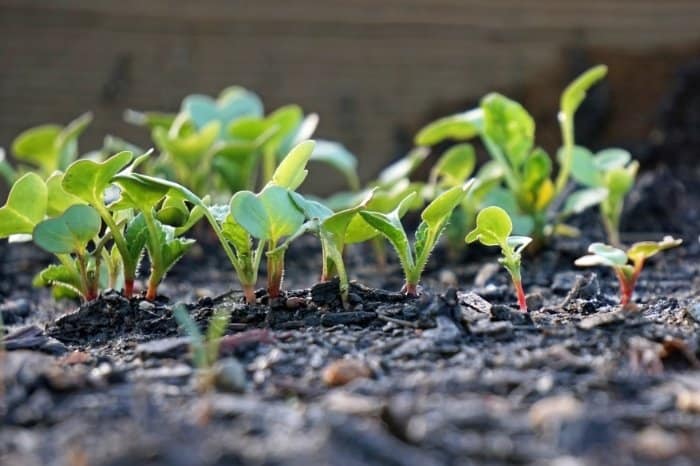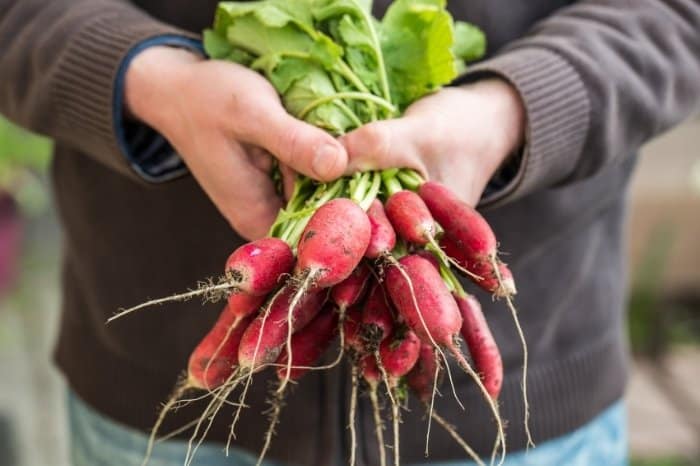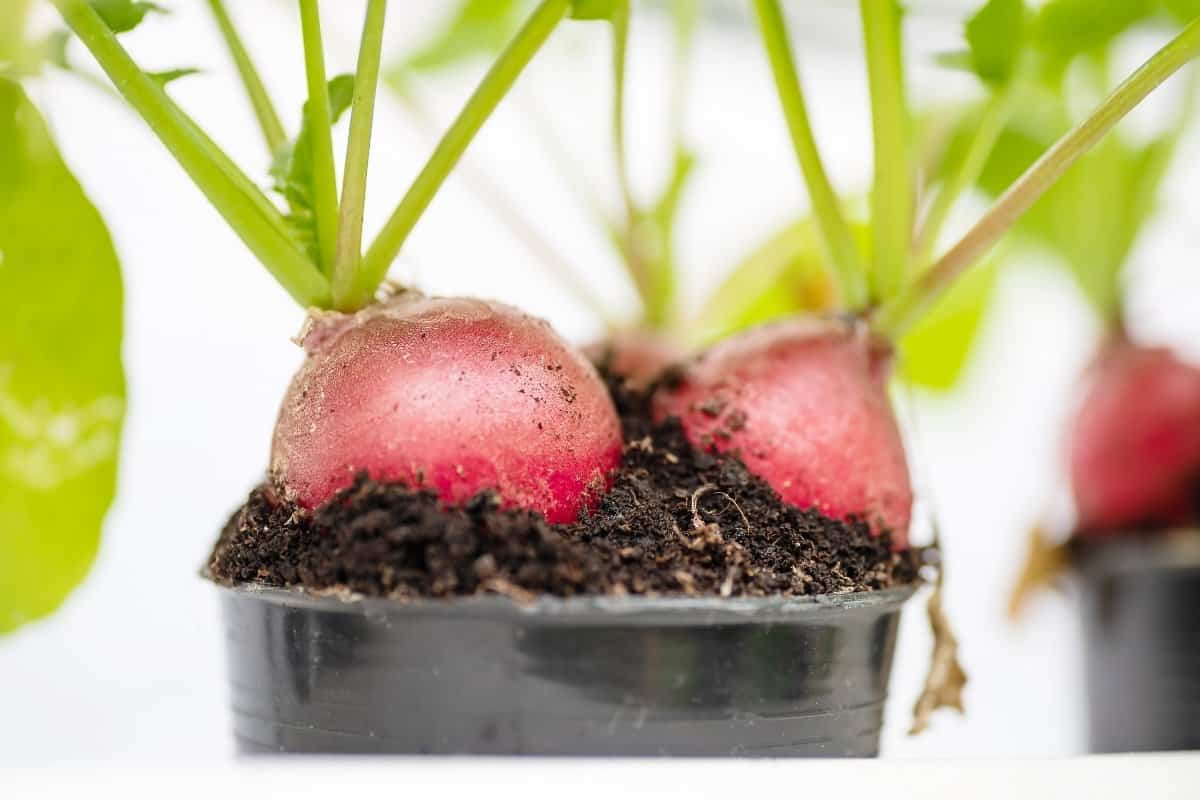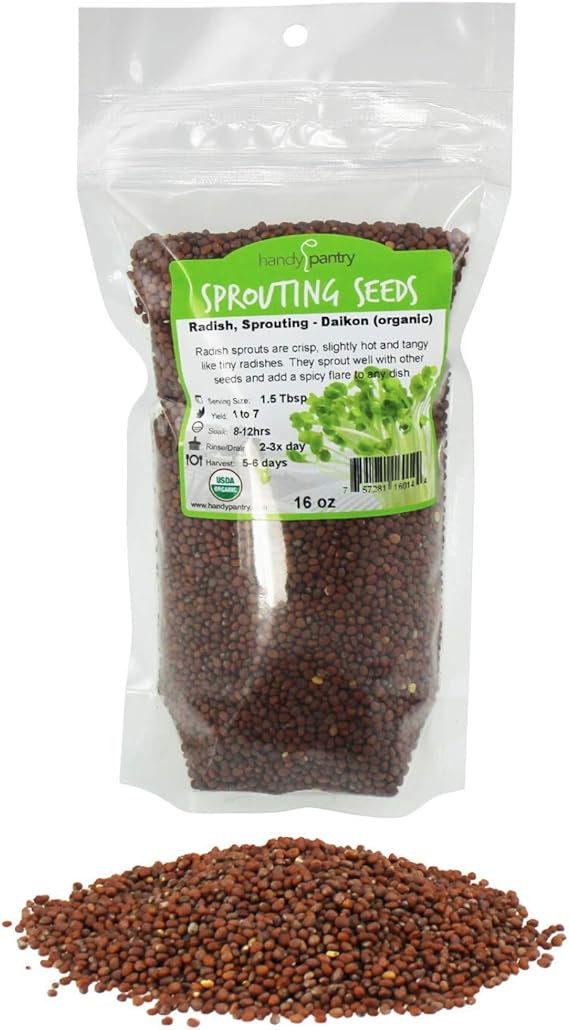Last Updated on January 18, 2023 by Urska
Radishes are easy to grow root vegetables that tolerate most soil types and are quick to grow; let’s look at how to plant radish seeds.
Growing radish from seed is like magic; throw the seeds onto the ground and cover them with half an inch of soil. Water them adequately and watch them grow.
Radishes always grow from seeds planted directly into the soil, where they grow to maturity. You do not need to start them indoors and later transplant them.
You can plant radish seeds in the spring and fall; however, suspend their growth in the summer season when temperatures are too high. Hot summer temperatures cause the radishes to bolt, making them inedible.
These delicious root vegetables are best eaten raw, providing a fiery burst of flavors to salads. They come in many cultivars to choose from, ranging from the red and white roots to long and thin in size.
Radishes are quick to grow; do not sow all the seeds in one go. Space them out at weekly intervals to get a successional crop to enjoy throughout summer.
Radish Seeds Facts
-
-
Radish seed packets carry around 250 to 500 seeds each.
-
A ½ ounce of radish seed is enough to yield up to a 100-foot long row of mature radishes.
-
Radish seed can remain viable for up to 4 years if stored in a cool, dark place.
-
75% of radish seeds in a packet will always germinate
-

How To Plant Radish Seed
-
Step 1: Prepare the bed where you want to sow your seeds. Rake the soil to a fine soft soil. Break down any large clumps and remove weeds, if any. Remove the lumps and large stones that will hinder the germination of the seedlings.
-
Step 2: Once the soil is ready, create a drill using a trowel, a line, and a reel. You can also attach a length of string to a cane at either end of the row.
-
Step 3: Sow your radish seed on your well-prepared drills. Space the seeds properly according to the instructions on the packet. Sow the seeds individually, rather than pouring them directly from the packet. Sow seeds about ½-inch deep and about 1-inch apart. Space them at least 8-12 inches between rows, depending on the variety. Lightly cover them with soil and water immediately. Use a watering can that will release water with grace. A hosepipe is too harsh on the newly sowed seeds. Continue watering every week if the weather is dry.
-
Step 4: Watch your seeds germinate. The seeds take only 4 to 5 days or at least 10 days maximum to germinate and show their first leaves. You can plant radish together with other slower-growing plants like beets or carrots. If you do so, mark the rows where you plant them, so you don’t dig them up accidentally when weeding.
-
Step 5: Thin your seedlings to 2.5cm. Once your seeds have germinated and have 2 to 3 leaves, thin them to create enough room to grow; being a root, it will need enough room to grow.
-
Step 6: Remove any weeds that may compete with the radishes for nutrients and water. Keep your soil moisturized throughout the growing season.
Radish harvest time comes in 20 to 30 days from sowing your seeds. Once they have gained full size, they are ready for harvesting. This will leave plenty of room for the other companion plants you had planted together. To check if your radishes are ready, scrape the topsoil layer before you harvest. If the radish is about 2cm in diameter, they are ready for harvest. To harvest gently pull from the soil, they come off fast and easy.
Radishes are best enjoyed when young. If you leave them in the ground for too long, they develop a bitter flavor and a woody texture.
When To Plant Radish Seeds
Radishes are always grown from seed. They are sensitive to transplanting, causing interruptions to their growth. It is, therefore, best to seed them directly outdoors.
Radish seeds are sensitive to frost. If required, sow the seeds indoors at least 2 weeks before the last frost date. If you sow the seeds indoors, use a biodegradable pot, so you plant the whole pot when it comes to transplanting them outdoors. You will minimize disruptions to the plant’s root system.
Organic Radish Sprouting Seeds – 1 Pound Non-GMO Daikon Radish Seeds
You can sow your radishes wherever there is a space, starting from early spring to early summer and again in the early fall.
Radish plant makes useful row markers when sown among slow-growing plants like carrots and parsnips. Since they germinate in a few days, it helps with weeding between the rows. By the time the late plants are germinating, it is almost time to harvest the radishes.
When To Harvest
It is best to enjoy your radishes when young. We cannot tire to alert you that they develop a sharp, bitter taste and a pithy texture if they are left in the ground too long.
They also split and lose their good flavor. Depending on the variety, you can start harvesting in 20 days from planting. Once the root becomes plump, they are ready for harvest.
Harvest the whole crop once, store it in the refrigerator, or harvest it 2 to 3 times before getting a bitter taste.
If you are harvesting in hot weather, remove all the radishes from the soil and drop them into a bucket of cold water. Remove the top greens and refrigerate them for up to 3 weeks. You can extend the storage up to several months in a proper root cellar.

Conclusion On How To Plant Radish Seed
Did you know you could gather your own seed for use the next season? If you want to do so, ensure that you grow only one radish variety in the garden. This is so that different radishes will not cross-pollinate and lose their individual characteristics.
To collect your own seeds, allow the radishes to produce flowers; they will mature into seedpods. You can support the stems, so they don’t fall over and burst.
As the seed heads mature, cover them with lightweight cloth bags to prevent the birds from eating the seeds. Once the seedpods dry, pick them and bring them indoors. Store them in a dry place until the next growing season.
What an easy way to grow your own radish and even gather your own seeds!
Caroline is a gardener who loves to get down to the nitty–gritty of gardening. She proudly proclaims herself as a ‘dirt worshipper‘ and can often be found deep in the garden, covered in soil and singing to her plants. As a self–proclaimed ‘plant whisperer‘, Caroline believes that plants need love and attention just like any other living thing, and she loves to give them both. When she‘s not tending to her garden, you can often find her researching the latest gardening trends, or teaching others how to make their gardens thrive



